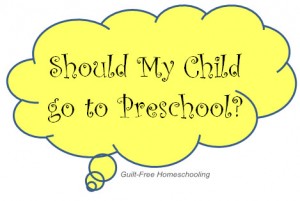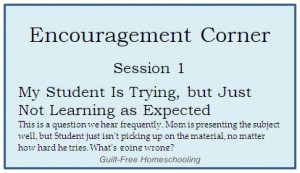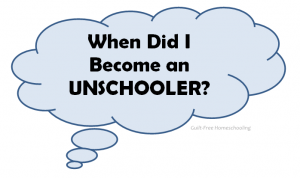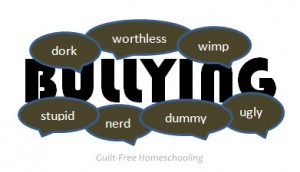These questions appear over and over in emails from parents who are considering homeschooling, regardless of the reasons. Here are the most frequent questions and our honest answers, in no specific order.
1. How soon can I pull my child(ren) out? Now—if that’s what your gut is telling you to do. Tell the office you have a “family emergency” and take your child(ren) home. Then check Home School Legal Defense Association’s website (hslda.org) for your state’s legal requirements and get that in order. If you prefer to wait a few days, weeks, or months before removing your student(s), that’s your decision—but please understand that you can remove them immediately. After all, if you have a reason that prompts you to consider homeschooling as an option, then you do have enough reason to remove them immediately, and they will benefit more from being at home than they would benefit from a few more days to finish out a week, a month, or a semester.
2. What curricula do I need? Start with nothing.
a) Begin by bonding with your child through shopping, movie-day, hanging out at the library, baking cookies, anything.
b) Explore an interest of your child’s through doing online research together, building a model, whatever. Follow every interesting bunny trail that comes along, because those paths are filled with great learning opportunities! (Someone decides which topics go into every textbook and how much each topic should cover—who says that your child’s bunny-trail interests are any less important or any less interconnected than the topics in a textbook? Bonus: your student will learn more and retain more from his bunny trails than from a textbook.)
c) Start slowly by using Google, Pinterest, or the library for one or two subjects and build your class load from there.
d) Allow each of these steps to progress as slowly or as quickly as needed. Your instincts will tell you when your student is ready to move on.
3. Can I remove just one of my children from public school? You could, but what’s the point?
a) Teaching more than one child is actually less work than shuttling several students back and forth all day to various activities in multiple locations.
b) Sibling bonding is just as valuable as parent-child bonding (see #2a-b above).
c) Do your other children deserve the same learning opportunities and freedoms as the one you want to bring home?
4. How do I teach several children at the same time? Any who can already read—can read.
a) Let older kids start the day with their favorite subjects that require the least help from you, allowing you to get a younger one started.
b) Kids don’t all have to be doing schoolwork at the same time. One can play with the toddler while another does math, then switch. For a time, my daughter got up early and did all her schoolwork from 6-10 in the morning, then worked on other projects throughout the day.
c) Let them assist each other when necessary, because Mom is not the only one capable of answering questions.
d) Problem-solving skills are developed through solving problems! I told my kids that if they got stuck they should try to figure it out themselves first, then ask their sibling for help or come find me at whatever chore I was doing. They were always proud to tell me what they had figured out on their own, and I was happy to praise them for it! Other options include phoning Grandma or asking Google—there are many ways to solve a problem.
5. How do I get the house cleaned and the laundry done?
a) Whose standards are you following? Sparkling clean houses with nothing out of place are owned by families who are never home.
b) Home Economics is a class we teach here. We used breaks between subjects as a way to get the wiggles out and get a few chores done. My kids were happy to carry their clean laundry upstairs and put it away because it meant a break from schoolwork. Unloading the dishwasher meant they could listen to the kitchen radio for the duration of that task. Taking out the trash could be followed by a few minutes on a swing. Breaks can be shortened or extended to fit the chore desired. Chores teach kids skills, responsibility, and independence—plus they break up the rest of the day while bringing real-world benefits.
6. Is it too soon/too late to pull my kids out? No.
a) Homeschooling has many more benefits than could possibly be gained from leaving them in longer. We began homeschooling when the school couldn’t cope with our child’s medical condition, but once she was home we found some serious academic deficiencies and other problems that we hadn’t realized existed. Don’t assume everything is fine at school, just because your child hasn’t complained.
b) A student at home can learn much more than a student in school, being free to move on at will instead of waiting for the entire class. A child who is motivated to learn can make incredible progress at home, making up for lost time and surging ahead in his chosen field of interest.
7. I’m thinking of homeschooling because [fill in the reason of your choice]. Is that a good enough reason? Yes, but you’ll also come up with several more good reasons as soon as you get started (see #6a above). My list of reasons for wanting to homeschool grew longer with every year that we homeschooled.
8. Can I teach my ADD/ADHD/ODD/ETC student without special training? Professional credentials don’t outweigh parental instincts. Moms and dads know their child and their child’s needs better than any professional ever will. A more accurate acronym-label for your child may actually be MIISE (More Interested In Something Else). Treat* your child for MIISE until that proves ineffective. Another syndrome common in the institutional classroom is TETL (Too Eager To Learn)—a phenomenon that classroom teachers find surprisingly difficult to manage while keeping to a schedule. Help your child follow his interests and coach him in learning to research the various aspects. Don’t be afraid to follow bunny trails and let topics run together in rapid succession. Genius flows easily across multiple ideas, and it’s the simpler mind that must limit itself to only one thought at a time. Forty-five minutes to an hour of following bunny trails will produce more significant learning than an entire day of planned lessons.
9. But what about friends? If they are a true friend, you won’t lose them. Homeschooling can be a great opportunity to ditch the troublesome relationships that needed to disappear anyway. In general, friends and acquaintances come from a variety of aspects in life: siblings, neighbors, cousins, church, clubs, sports, music lessons, friends of friends, etc. Today’s social media phenomenon provides an avenue for maintaining close contact with friends regardless of distance or schedules.
10. We can’t do sports, music, or other extra-curricular activities at home. Are those just out of the picture for homeschooling? No. There are numerous possibilities for private lessons and group participation that don’t involve public school:
- You Tube, Netflix, Google, online instruction and/or tutorials
- Homeschool curriculum for the desired skill
- Private tutor or coach, who could range from an advanced student to a professional teacher for the desired skill
- Homeschool co-op group offering team sports, band, etc.
- Church-based or community-sponsored sports & recreational activities
- Dual-enrollment with public or private school for specific activities
HSLDA has discouraged families from trying to “keep one foot in both worlds” through dual-enrolling for specific classes or activities. And I agree. When we left the government school system, we were ready to break all ties and not look back. Then a community-wide sports activity became available that was run through the schools but didn’t require dual-enrollment, and my kids were interested in participating. I inquired about whether this was strictly a school-sponsored group (no, it was funded by participants) and if homeschooled members of the community could be involved (they supposed so), and we went to their first session of the year and signed up. It seemed to be going well for the first few practices and even through the first public performance, but things quickly went downhill after that. We weren’t notified of subsequent exhibitions, and the group’s leader made it increasingly difficult for my kids to participate, to the point where we eventually felt it was in our best interests to withdraw from that group and focus our efforts in more homeschool-friendly areas.
Throughout our homeschooling career, we knew other homeschooling families whose students participated with private schools, public schools, community groups, church groups, or homeschool co-op groups for a variety of extra-curricular experiences. The opportunities can be found or created to suit the needs, but the bigger questions is why is it necessary? Discuss this as a family to determine your motivation, whether for music, sports, drama, foreign languages, artistic endeavors, or whatever. Are your students just looking for a place to hang out with friends, or are they genuinely interested in learning the skill? Are Mom and Dad trying to live their own lives over again through their children, or is this something the student truly desires for himself?
Yes, Harvard has been known to award scholarships to distinguished harpists, but is winning a 1-year scholarship to an Ivy League college the only reason for dedicating a minimum of ten years of one’s childhood to an instrument (especially if the child lacks the passion to maintain this as a life-long activity)? The price of the instrument(s), the cost of years of weekly lessons, and the time investment for enough daily practice to become such an accomplished player as to merit a prestigious scholarship could all have been applied toward another area that the student enjoyed and appreciated more than being able to say “But it got me into Harvard.” Were all those years of music lessons merely the foot-in-the-door for a college education leading to a non-music-related career goal? Was the motivation just to give Mom and Dad the bragging rights of “Our kid’s going to Harvard”? Could the time, energy, and resources have been better directed toward the student’s desired career path? Could the same amount of money have been invested in such a way as to return an amount equal to or greater than the scholarship itself?
The freedom and flexibility provided by homeschooling can be used to the student’s advantage in numerous, subtle ways, resulting in a focused interest, rather than a schedule filled with diverse activities that yield more social involvement than academic advancement. I would rather see a student pursue his interests as vocational preparation than devote his time to activities that merely serve to fill his calendar with a variety of time-consuming distractions.
For more info, check out these links:
Leaving Public School
*How to Adapt Lessons to Fit Your Student’s Interests and Make Learning Come Alive
Teach Your Students to Teach Themselves
Knowing How to Find the Answer Is the Same as Knowing the Answer
People LIVE in This House
Using Your Household Staff
Family Is Spelled T-E-A-M
Consider this one as the answer for the unofficial Question #11:
Homeschooling an Only Child









 Guilt-Free Homeschooling is the creation of Carolyn Morrison and her daughter, Jennifer Leonhard. After serious disappointments with public school, Carolyn spent the next 11 years homeschooling her two children, from elementary to high school graduation and college admission. Refusing to force new homeschooling families to re-invent the wheel, Carolyn and Jennifer now share their encouragement, support, tips, and tricks, filling their blog with "all the answers we were looking for as a new-to-homeschooling family" and making this website a valuable resource for parents, not just a daily journal. Guilt-Free Homeschooling -- Equipping Parents for Homeschooling Success!
Guilt-Free Homeschooling is the creation of Carolyn Morrison and her daughter, Jennifer Leonhard. After serious disappointments with public school, Carolyn spent the next 11 years homeschooling her two children, from elementary to high school graduation and college admission. Refusing to force new homeschooling families to re-invent the wheel, Carolyn and Jennifer now share their encouragement, support, tips, and tricks, filling their blog with "all the answers we were looking for as a new-to-homeschooling family" and making this website a valuable resource for parents, not just a daily journal. Guilt-Free Homeschooling -- Equipping Parents for Homeschooling Success!

Recent Comments